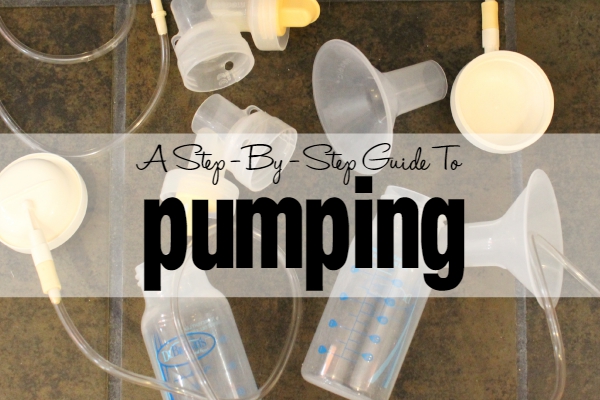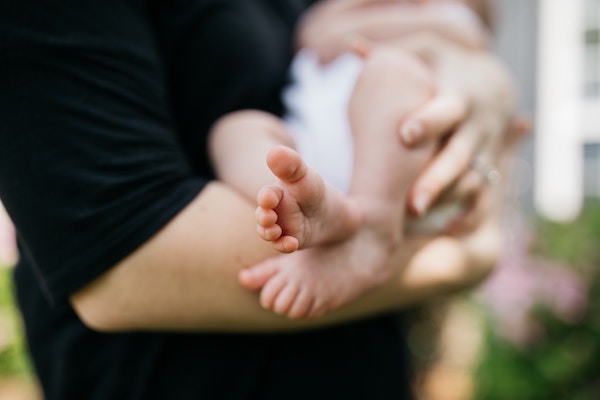After my first baby arrived and I realized I wanted to detach myself from him at times, I scurried to the Internet with one burning Google search… “How to start pumping.” And you know what I found….NOTHING! I could not find any resources explaining the basic steps for how to begin pumping. How to start from ground zero, in layman’s terms. So, for all of you new moms figuring out how to pump for the first time…this post is for YOU.

When should I do it?
The best time to pump is after you feed your baby, that way the baby still gets all of the hind milk {the fatty, good stuff that gives your baby rolls on rolls}. And most experts suggest waiting until your baby is at least six weeks old before pumping so that you have established your supply. For your very first pump, try it in the morning, after baby’s first feeding, since there will have been a span of a few hours overnight in between feedings. {At least, we hope.} You’ll produce more, and feel more confident about the volume you produced.
What do I do?
To get started, I highly recommend purchasing a hands free pump bra. It’ll change your life. Trust me. Some people take an old sports bra and cut holes in it around the nipple area, about the size of a quarter. That also works; just make sure the band of the bra gives you a snug fit. {And be sure to check out these other breastfeeding/pumping essentials too!}
After you’ve got the pumping bra on, it’s time to get hooked up. Take the connector and twist it on securely to a bottle or bag, whichever you are pumping in to. I always preferred to pump into bottles because I got a more accurate measurement of the milk. I was pretty rigid about wanting to know exactly how much I pumped for the purpose of making bottles and freezing any extra.
Next, take the connector and connect it to the breast shield {you know – the piece that looks like a cone}.
Depending on the pump you have, you will have tubes coming out of the top or bottom of the pump. Make sure to secure those tightly to the output and into the connector, or the pump won’t function properly.
Once you are all set up, take a deep breath and turn the pump on. I know…it’s not comfortable. But you gave birth, so really this is nothing in comparison, right?
If you have a pump that allows you to adjust the dial, start out on 1 for at least two minutes until you feel the let down. This can take anywhere from 30 seconds to two minutes. If you have a hospital grade machine, it is already configured to do this for you. The pump will run slower at the beginning and then will speed up as you go along. Feel free to adjust the speed to your comfort level.
So, how long do I pump for?
The short answer – until milk stops coming out. Give yourself at least ten minutes for each pumping session to get the rhythm going. The maximum amount of time to pump is thirty minutes.
At the end of your pumping session, unhook the contraption, but leave the machine on for a minute to let the tubes air out before turning the pump off.
And always make sure to wash and sterilize your pumping parts in between sessions. The multi-use microwave steam bag is your friend! If you are pumping at work, pack some baby wipes in your bag to clean the parts after you are done pumping, and then wash them thoroughly when you get home.
Tips & Tricks
- Some moms enjoy looking at photos and videos of their baby during pumping sessions. The belief behind this is that looking at pictures and thinking about your baby produces more milk. I never bought into that and took those minutes to catch up on social media and read the news.
- I know many moms who pump in the car on the way to or from work. I think this is such a productive use of time. If you have a battery operated pump or car adapter, why not? I don’t know a single Houston mom who wouldn’t give you a thumbs up for your multitasking!
- Just to reiterate what was mentioned above, a hands free bra is a wonderful investment. I highly recommend this one. There are few things worse than sitting there frozen still with your hands holding the breast shields.
- Most experts recommend you remember the number FOUR. Freshly expressed {or warmed} milk is good for four hours at room temperature. It can stay in the refrigerator up to four days, and in a normal freezer up to four months. If you choose to store milk in a deep freezer, it’s good for a year.
- If you are a working mom, pack your pumping bag the night before and then double check it in the morning before leaving the house. Without the correct parts, you won’t be able to pump.
- In your pumping bag, include some washable or single-use breast pads and slip those on before returning to your desk to prevent any awkward leaking.
- Keep Vaseline handy when pumping for sore nipples. Some moms have found this helpful to use before the pumping session begins.
- Know your rights as a working breastfeeding mom. If you are an hourly employee, your employer is required by federal law to provide you with a private space to pump that is not a restroom. Read this to become fully informed about your rights before returning to work. You can breastfeed and be a full-time working mom.
- In the end, everyone hates pumping. It’s something that ALL moms have in common. I’ve yet to meet a mom friend that enjoys feeling like a cow being milked. And the swooshing sound of the pump…no, thank you!
For me, I can compare pumping to my relationship with tomatoes. They’re not my favorite, but I eat them because they are good for me. Pumping was hardly my favorite, but it was good for my baby and allowed me to continue breastfeeding while working. And for me, that was worth the sacrifice every time.
















Awesome information here, truly helpful. Pumping is not my favorite too because there always be gloomy days when milk let down is little. But thanks to better days which are more and when milk flows are easier than ever.